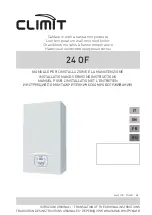
38
Cleaning the Hydronic System
IMPORTANT: Do not mix different manufacturers’ products.
Doing so will void the warranty of the boiler.
Consideration MUST be given to cleaning the heating system,
particularly in retrofit situations where a new boiler with an
aluminum heat exchanger is being installed in an existing pip-
ing system.
All existing systems must be cleaned and flushed according to
the antifreeze manufacturer’s recommendations.
Systems that have antifreeze that is not recommended by the
boiler manufacturer must be completely flushed to ensure no
unapproved antifreeze remains according to the recommended
antifreeze manufactures recommendations. Evidence of an
alternate antifreeze in the system may void the boiler warranty.
In older systems obviously discolored, murky or dirty water;
or a pH reading outside the boiler manufacturer’s stated ac-
ceptable range (pH 7.0 to 8.0) are indications that the system
should be cleaned or treated.
Measure total capacity of the system including the pip-
1.
ing, tanks, boiler, collector plates, etc. The most accurate
method of measuring fluid capacity is to fill the system
and then completely drain it, volumetrically measuring the
fluid drained.
Thoroughly flush the system with clean water to remove
2.
any sediment or contaminants. Sludge and iron oxide
deposits can cause rapid breakdown of inhibitors.
Cleaning fluid – Flushing with clean water is preferred. If
3.
cleaning fluid is used, only use cleaner specifically ap-
proved for use with aluminum boilers. Use only cleaning
fluids and the procedure recommended by the antifreeze
manufacturer.
Freeze Protection
Aluminum Safe Antifreeze, Treatments and Additive
Guidelines:
Antifreeze, if required, must be one of the antifreeze manufac-
turers listed in this manual. See the “Recommended Alumi-
num Antifreeze & Inhibitor Suppliers” section of this manual
for a list of boiler manufacturer approved products.
Always clean system prior to using antifreeze, refer to the
Cleaning the Hydronic System section of this manual for
details.
Only use the antifreeze manufacturers’ products outlined in
this document.
Use of antifreeze must be in accordance with local plumbing
codes.
Dispose of old antifreeze and boiler system water in accor-
dance with local authorities.
Antifreeze will raise the pH of the hydronic solution in a
heating system above the recommended level due to the
corrosion inhibitors in the antifreeze.
The solution must
be treated to maintain a pH within the boiler manufacturer’s
recommended level to avoid damage to the heat exchanger.
Follow antifreeze manufacturer’s instructions for details on
how to adjust the pH.
If the system has leaked for some reason, the water and anti-
freeze chemistry will need to be adjusted. To avoid damage to
the boiler, check the pH and chemistry of the boiler solution
and consult the antifreeze manufacturer for recommendations.
It is recommended that a pH reading is taken annually, and ad-
justed as necessary. Follow antifreeze / inhibitor manufacturer’s
instructions for details on how to adjust the pH.
Use of antifreeze in any boiler will reduce heating capacity
•
as much as 10-20%. This must be taken into consideration
when sizing the heating system, pumps and expansion tank.
Consult antifreeze manufacturer’s literature for specific in-
formation on reduced capacity.
Using the antifreeze manufacturer’s instructions to determine
•
the freezing temperature needed and use the correct amount of
antifreeze. Never exceed 50% antifreeze by volume.
The boiler operating pressure must remain below 15 psi
•
for antifreeze solutions that specify a maximum of 250˚F
(121˚C).
WATER TREATMENT & FREEZE PROTECTION
Antifreeze solutions can breakdown over time. Failure to
check antifreeze chemistry, including inhibitors, annually
may result in accelerated corrosion of boiler and other sys-
tem components. Consult with the antifreeze manufacturer
for recommendations.
NOTICE
Summary of Contents for UB90-100
Page 15: ...15 Near Boiler Piping Figure 2 Single Zone Boiler Piping ...
Page 16: ...16 Figure 3 Multi zone Boiler Piping With Zone Valves Near Boiler Piping ...
Page 19: ...19 Figure 6 Diaphragm Type Expansion Tank Piping Near Boiler Piping ...
Page 20: ...20 Figure 7 Conventional closed type Expansion Tank Piping Near Boiler Piping ...
Page 27: ...27 Combustion Air and Vent Pipe Figure 11 Combustion Air and Vent Piping ...
Page 32: ...32 Electrical Wiring Figure 13 Field Wiring Connections ...
Page 53: ...53 DETAILED SEQUENCE OF OPERATION ...
Page 57: ...57 TROUBLESHOOTING CHART 2 TROUBLESHOOTING ...
Page 58: ...58 TROUBLESHOOTING CHART 3 TROUBLESHOOTING ...
















































